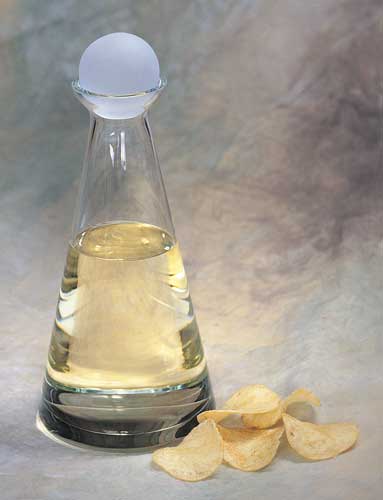New Insights Into Nutritional Oils
NUTRACEUTICALS
 The call for clean label, transparency, and nutrition has continually grown and affected the development of all ingredients, including fats and oils. “Clean label, especially related to partially hydrogenated oil (PHO) replacement, organic, and non-GMO, has been a major consumer trend,” says James Haddon, strategic marketing director, global edible oils solutions at Cargill. “Clean label means different things in different parts of the world, and trends are highly dependent on the category and region.” He explains that in the United States, producers have been removing PHOs over the last few years, which was accelerated by the U.S. Food and Drug Administration’s determination that PHOs are no longer generally recognized as safe (GRAS). “As of June 18, 2018, PHOs may only be used after FDA approval. Other countries, including Europe, Russia, India, Taiwan, and Canada, are taking action on PHOs subsequent to the U.S. FDA determination.”
The call for clean label, transparency, and nutrition has continually grown and affected the development of all ingredients, including fats and oils. “Clean label, especially related to partially hydrogenated oil (PHO) replacement, organic, and non-GMO, has been a major consumer trend,” says James Haddon, strategic marketing director, global edible oils solutions at Cargill. “Clean label means different things in different parts of the world, and trends are highly dependent on the category and region.” He explains that in the United States, producers have been removing PHOs over the last few years, which was accelerated by the U.S. Food and Drug Administration’s determination that PHOs are no longer generally recognized as safe (GRAS). “As of June 18, 2018, PHOs may only be used after FDA approval. Other countries, including Europe, Russia, India, Taiwan, and Canada, are taking action on PHOs subsequent to the U.S. FDA determination.”
Food manufacturers have been reformulating and looking for solutions to address PHO replacement as well as clean labeling, transparency, and nutrition. Mainstream high oleic oils, such as soy, canola, and sunflower, as well as palm oil and interesterified oils currently help developers in their endeavors. Here is a look at some of the recent news regarding these as well as other up-and-coming niche nutritional oils that have been touting their beneficial health properties.
Sunflower Oil
This past August at a National Sunflower Association media event, speakers from ADM, Cargill, and Stratas Foods discussed the evolution of fats and oils in the food industry and sunflower oil’s role as a replacement oil. “The upcoming ban on PHOs, potential legislation related to GMOs, and consumer demand for cleaner ingredients are some of the top trends facing food manufacturers today,” stated John Sandbakken, executive director of the National Sunflower Association. “Sunflower oil is the ideal fit for these trends since it is trans fat-free, non-GMO, and can contribute to cleaner ingredient decks. Over the years and through traditional breeding, the nutrition profile of sunflower oil has evolved and now there are mid- and high-oleic sunflower oils that offer extended shelf and fry life, a better nutrition profile, and excellent blending qualities to food manufacturers.” With the approaching deadline for the ban on PHOs, sales of sunflower oil continue to grow, and domestic sales have increased 18%.
Natural sunflower oil is produced from oil-type sunflower seeds. It is a combination of monounsaturated and polyunsaturated fats with low saturated fat levels, and supplies more vitamin E than other popular vegetable oils. There are currently two types of sunflower oil produced in the United States, NuSun (mid-oleic) and high oleic oil. All are developed with standard breeding techniques. They differ in oleic levels, offering unique properties.
Stratas Foods offers a high oleic sunflower oil. At the media event, Brian Owens, vice-president of oil procurement and risk management at Stratas Foods, explained how high oleic sunflower oil is naturally high in antioxidants, which helps protect the oil flavor, is domestically sourced, and is similar to extra virgin olive oil due to its oleic acid content. “High oleic sunflower oil is on target with consumer trends, including indulgence, simple ingredients, healthy, fresher and longer shelf-life, and transparency in food labeling.”
Soybean Oil
In July of this year, the FDA approved a qualified health claim linking the consumption of soybean oil to reduced risk of coronary heart disease. The petition, filed by Bunge North America, pointed to the potential heart health benefits of soybean oil, and manufacturers may now communicate that soybean oil may reduce coronary heart disease risk and lower LDL cholesterol when replacing saturated fat and not increasing calories. The new heart-healthy claim states, “Supportive but not conclusive scientific evidence suggests that eating about 1 1/2 tablespoons (20.5 g) daily of soybean oil, which contains unsaturated fat, may reduce the risk of coronary heart disease. To achieve this possible benefit, soybean oil is to replace saturated fat and not increase the total number of calories you eat in a day. One serving of this product contains [x] grams** of soybean oil.”
Through biotechnology, high oleic soybean oil is available. In addition, more innovation is to come. QUALISOY promotes new and improved trait-enhanced soybean oils that benefit the entire soybean value chain. For example, the first increased omega-3 soybean is in development. The increased omega-3 soybean is rich in stearidonic acid (SDA) omega-3 fatty acids. SDA omega-3s are more efficiently converted by the body into EPA, so increased-omega-3 soybeans are a land-based source of the beneficial fatty acids found in fish. According to QUALISOY, the FDA approved the use of omega-3 soybean oil with SDA for use in food and beverages. Farmers will begin production of SDA omega-3 soybeans pending the approval of the U.S. Dept. of Agriculture. Companies developing these soybean varieties aim for an omega-3 content of 18%–20%.
 Canola Oil
Canola Oil
Canola oil carries a Qualified Health Claim linking 1 1/2 tablespoons of canola oil per day to a possible reduced risk of coronary heart disease when used in place of saturated fat. It is low in saturated fat, high in monounsaturated fat, high in omega-3 fat (alpha-linolenic acid), free of trans fat and cholesterol, and a good source of vitamins E and K and plant sterols. In a review of 31 studies examining the effects of canola-based diets, Lin et al. (2013) concluded that growing scientific evidence supports the use of canola oil, beyond its beneficial actions on circulating lipid levels, as a health-promoting component of the diet. Data revealed substantial reductions in total cholesterol and LDL cholesterol, as well as other positive actions, including increased tocopherol levels and improved insulin sensitivity.
Cargill offers Clear Valley high oleic canola oil. “High oleic canola oil is mostly comprised of unsaturated fat, with low levels of saturated fat, and has zero grams of trans fat per serving,” says Haddon. “Clear Valley high oleic canola oil has an extended fry life and improved shelf stability, and is therefore sold primarily to food companies and foodservice operations to make their food last longer for customers.”
 Dow AgroSciences offers Omega-9 Canola Oil. Through traditional plant breeding, the company developed an improved fatty acid profile in canola, with zero trans fats and low saturated fats per serving. The new technology was named Omega-9 Canola Oil due to high levels of its namesake omega-9 monounsaturated fats. “Omega-9 Canola Oil provides a functional, heart-healthy alternative to oils that are partially hydrogenated or high in saturated fats,” states Dave Dzisiak, commercial leader for oils and grains at Dow AgroSciences. “As a result, Omega-9 oils have removed about 1.5 billion pounds of these bad fats from the North American food supply since they were commercialized. The oils market already has responded to the call to eliminate trans fats and reduce saturated fats in the diet, shifting demand to alternatives like Omega-9 canola. In response, canola overall has become the second-largest oilseed crop in North America.”
Dow AgroSciences offers Omega-9 Canola Oil. Through traditional plant breeding, the company developed an improved fatty acid profile in canola, with zero trans fats and low saturated fats per serving. The new technology was named Omega-9 Canola Oil due to high levels of its namesake omega-9 monounsaturated fats. “Omega-9 Canola Oil provides a functional, heart-healthy alternative to oils that are partially hydrogenated or high in saturated fats,” states Dave Dzisiak, commercial leader for oils and grains at Dow AgroSciences. “As a result, Omega-9 oils have removed about 1.5 billion pounds of these bad fats from the North American food supply since they were commercialized. The oils market already has responded to the call to eliminate trans fats and reduce saturated fats in the diet, shifting demand to alternatives like Omega-9 canola. In response, canola overall has become the second-largest oilseed crop in North America.”
Dzisiak adds that Dow AgroSciences is continually exploring new opportunities to develop better plants and make healthier ingredients. In addition to Omega-9 Canola Oil, Dow researchers have improved the sunflower seed oil profile. When it becomes available, Omega-9 Sunflower Oil will be able to boast a saturated fat–free claim per serving and high levels of heart-healthy monounsaturated fats.
--- PAGE BREAK ---
Fish and Marine Oils
Fish- and marine-based oils are accepted by consumers as healthy oils because of their omega-3 fatty acid profiles. In a meta-analysis, Miller et al. (2014) showed that available evidence from 70 randomized controlled trials indicated that provision of EPA+DHA reduced systolic blood pressure. The strongest effects of EPA+DHA were observed among untreated hypertensive subjects, although blood pressure also was lowered among normotensive subjects.
At this year’s SupplySide West show, several suppliers showcased the versatility of fish- and marine-based oils. For example, DSM showcased its omega-3 offerings in beverages, including mango peach, lemon zest, piña colada, and key lime. The beverages provided between 720–1,500 mg of EPA and DHA. DSM offers life’sDHA, a vegetarian source of DHA omega-3 from algae. MEG-3 fish oil is a source of EPA and DHA omega-3 without the fishy taste or smell. life’sOMEGA is also an algal source of EPA and DHA omega-3. Maki et al. (2014) demonstrated that life’sOMEGA lowered triacylglycerol levels to a degree that was not different from that of a standard fish oil product, and that was significantly more than for a corn oil/soy oil control.
Stepan Lipid Nutrition offered a pink grapefruit omega-3-fortified water. The company offers Marinol, which is available in the form of a highly concentrated oil and a high-stability powder that offer different EPA and DHA ratios to provide specific health benefits.
Algarithm served algal DHA Omega Breakfast with Bacon Smoothies as well as burgers and s’more-flavored smoothies. There were also samples of the company’s DHA algal oil. Algarithm offers a 40% algae DHA oil, alphamega, which is vegetarian and non-GM.
Rimfrost discussed recent research on krill oil, a source of omega-3 fatty acids and protein. RIMFROST Antarctic krill oil provides omega-3s bound to phospholipids. Parolini et al. (2017) looked to evaluate the effect of Antarctic krill components on plasma lipids and atherosclerosis development in 60 apoEKO mice (a model of dyslipidemia and atherosclerosis). The krill oil diet was shown to reduce cholesterol levels, inhibit plaque development, and prevent liver damage. Krill proteins also reduced atherosclerosis development through mechanisms not involving lipid metabolism.
In June of this year, PLT Health Solutions introduced élantria Algal DHA, an ultra-stable algal DHA produced from non-GM microalgae Schizochytrium sp. élantria Algal DHA delivers 40% DHA by weight in an ultra-stable, nonconcentrated form. From a product developer’s standpoint, one of the features of élantria Algal DHA that stands out is its stability and shelf life.
In April, ADM introduced Onavita DHA Algal Oil. The new DHA oil is produced from a high-quality, reliable U.S. algae supply. Onavita DHA Algal Oil can be used in a wide variety of dietary supplements and fortified food products and provides vegan and allergen-free labeling options for food, beverage, and supplement developers.
Flaxseed Oil
Flaxseed’s nutritional profile includes being high in fiber, omega-3 fatty acids, and lignans. More than 70% of fat in flax is of the healthful polyunsaturated type. What makes flax oil unique is its high ratio of alpha-linolenic acid (an omega-3 fatty acid) to linoleic (omega-6 fatty acids). Last year, ADM also launched Onavita Flaxseed Oil. The oil features non-GM plant-sourced omega-3s. The FDA considers products containing at least 160 mg of alpha linolenic acid/serving, like what is found in Onavita flaxseed oil, to be a good source of omega-3s.
Chia Oil
The chia seed is popular in the health arena because it is high in omega-3 fatty acids, fiber, and calcium. At SupplySide West, Benexia showcased a plant-based ultra-high temperature pasteurized chia milk. The company also offers cold-pressed and filtered chia oil. It has a high concentration of alpha-linolenic acid. The most important antioxidants found in Benexia Chia Oil are chlorogenic acid and caffeic acid. Both components contribute in a significant proportion to the strong antioxidant activity of Benexia Chia Oil. Chia oil naturally contains tocopherols and phytosterols, which in addition to contributing to high oxidative activity, have beneficial effects for the prevention of cardiovascular conditions.
Cranberry Seed Oil
Fruit d’Or cranberry seed oil is approved by Health Canada for maintenance of good health. Fruit d’Or Nutraceuticals has received Natural Product Number (NPN #80079040) from Health Canada’s Natural and Non-prescription Health Products Directorate, for both Cran Naturelle and Cran d’Or cranberry seed oil. Fruit d’Or cranberry seed oil is registered with an NPN claim as a “source of omega-3 and omega-6 fatty acids for the maintenance of good health.” Each tablespoon (15 ml) contains 34.8% of alpha-linolenic, 36.6% of linoleic, and 19.9% oleic acid.
Next month’s Nutraceuticals column will give an update on nutritional innovations in beverages.
 Linda Milo Ohr,
Linda Milo Ohr,
Contributing Editor
Denver, Colo.
[email protected]
References
Lin, L., H. Allemekinders, A. Dansby, et al. 2013. “Evidence of Health Benefits of Canola Oil.” Nutr. Rev. 71(6): 370–385.
Maki, K. C., K. Yurko-Mauro, M. R. Dicklin, A. L. Schild, and J. G. Geohas. 2014. “A New, Microalgal DHA- and EPA-containing Oil Lowers Triacylglycerols in Adults with Mild-to-moderate Hypertriglyceridemia.” Prostaglandins Leukotrienes Essent. Fatty Acids. 91(4): 141–148.
Miller, P. E., M. Van Elswyk, and D. D. Alexander. 2014. “Long-chain Omega-3 Fatty Acids Eicosapentaenoic Acid and Docosahexaenoic Acid and Blood Pressure: A Meta-analysis of Randomized Controlled Trials.” Am. J. Hypertension. 27(7): 885–896.
Parolini, C., B. Bjorndal, M. Busnelli, et al. 2017. “Effect of Dietary Components from Antarctic Krill on Atherosclerosis in apoE-Deficient Mice.” Mol. Nutr. Food Res. Advanced online publication, Aug. 15. doi:10.1002/mnfr.201700098.


